(1488 products available)














































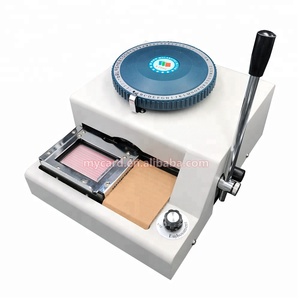


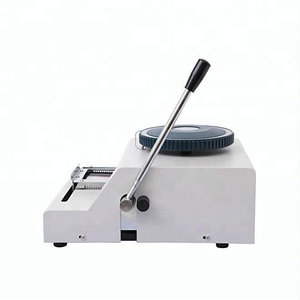
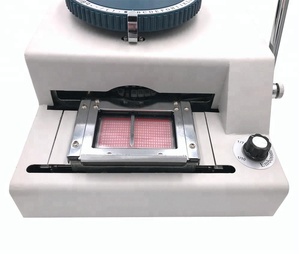
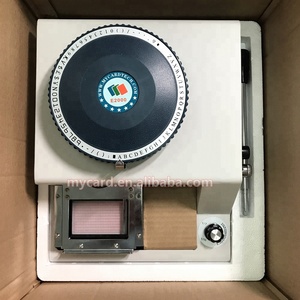



















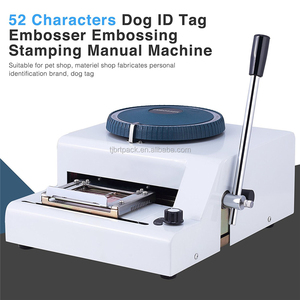





































































































There are several types of manual number plate embossing press machines. The machines may vary in size, operation, and design. Here are some of the common types:
Hand-operated embossing press
This is the most common type of manual number plate embossing machine. It is designed for small businesses and workshops that produce number plates in small quantities. The machines have a basic design and are easy to operate. Users of hand-operated presses emboss registration plates by hand-cranking or lever-pressing the desired characters.
Manual rotary embossing machine
Manual rotary embossing machines are designed to create more complex patterns on number plates. The plates are rolled or turned under stationary embossing elements. This allows for continuous embossing along a plate's length. Rotary machines are ideal for customizing longer registration plates.
Foot-operated embossing press
Foot-operated presses use pedals to control pressing plates. Operators use their hands to feed materials and control the embossing process, leaving both hands free for handling tasks. Foot-operated presses can be manually or mechanically powered.
Die-casting number plate machines
Manual die-casting number plate machines are used to form characters on metal plates by pouring molten metal into a mold. The mold contains a cavity in the shape of the desired plate. Once the metal cools and solidifies, it takes the shape of the cavity. Manual die-casting number plate machines are used to make plates with complex designs and features.
Combination embossing machines
Some manual number plate embossing machines combine multiple functions into a single unit. For instance, cutting, bending, embossing, and engraving functions may be combined. Combination machines enhance versatility and efficiency in number plate production.
Manual number plate embossing press machines come in a variety of sizes, designs, and specifications depending on the manufacturer and the intended use. Here are some common general specifications:
Embossing Area:
This refers to the maximum size of the characters or letters that can be embossed. It may be 520 x 112 mm or any other suitable dimension.
Plate Thickness:
Different users work with plates made of different materials. Therefore, manual number plate embossing machines can be designed to handle plates with varying thicknesses, typically between 0.8 and 4 mm.
Machine Dimensions:
The size of the machine can affect its portability and the space it occupies at the workplace. The machines have varying weights and dimensions, which may range from 60 kg and 1500 mm in length, 600 mm in width, and 1000 mm in height.
Power Requirements:
These machines are mainly manual; hence, they have low power requirements or none at all. In some cases, they may require connection to a power source of about 220V AC.
Letter and Number Sizes:
Some machines have fixed letter and number sizes, while others are adjustable to accommodate various requirements. Fixed sizes range from 50 to 100 mm in height.
Material Construction:
To ensure durability and reliability, these machines are made from high-quality materials. The most common include steel, aluminum, and cast iron.
Filling Type:
Some machines use water-based inks, while others use solvent-based inks. Each filling type offers different characteristics, such as quick drying for solvent-based inks.
Application:
Different machines are suitable for various applications, including vehicle registration, industrial licensing, and commercial branding. Some are designed specifically for one application, while others can be used for many.
It is important to note that different manufacturers have varying specifications for their machines. Therefore, it is necessary to consult the user manual or contact the supplier for detailed specifications.
To ensure the manual number plate embossing press machines work efficiently and last longer, regular maintenance is important. Here are some general maintenance guidelines:
When buying a manual number plate machine for resale or business, consider the following:
Brand reputation
Buy from suppliers who sell reputable brands. The brands should have a good reputation in the market. Their machines should have a good track record of reliability, quality, and durability.
Quality and construction
The quality and construction of the embossing press machine are vital when choosing a manual number plate machine. Select machines with robust and durable constructions. The machines should have quality materials such as cast iron or steel.
Adjustability and versatility
Consider the adjustability and versatility of the embossing press machine. The machine should accommodate different plate sizes and be able to engrave various designs and fonts.
Ease of use
When choosing a manual number plate embossing press machine, consider the ease of use. Select machines with simple and clear setup instructions. Additionally, consider machines with ergonomic designs.
Portability and storage
Consider the manual number plate embossing press machine's portability and storage. If the machine is compact and lightweight, it will be portable and easy to store.
Accessories and additional features
Consider the additional features and accessories of the manual number plate embossing press machine. Some machines may come with additional tools, such as cutting jigs or handles, which can be useful.
Price and warranty
Consider the price and warranty of the manual number plate embossing press machine. Get machines with a good price-to-value ratio. Furthermore, select machines with quality warranties to protect the investment.
It is quite easy to DIY and replace a manual number plate embossing press machine. Here is how to do it:
Check the power
Before anything else, users should ensure that the machine is properly powered. For battery-powered machines, the batteries should be fully charged or not drained. Also, in case there are loose wires, users should ensure that they are properly secured and connected to the machine.
Inspect the machine
Users should thoroughly inspect the machine to ensure that everything is intact and working as it should. In case there are damaged parts, the users should replace or repair them immediately. The parts that should be checked include the embossing rollers, guiding plates, and the handle.
Check the alignment
Users should ensure that all the parts of the machines are properly aligned to avoid jams and obstacles when operating. In case the parts are misaligned, they should be adjusted appropriately.
Refer to the manual
In case users face any difficulties when operating the manual number plate embossing press machine, they should refer to the user manual. The user manual contains instructions and guidelines on how to use the machine properly.
Q1. Are there any safety measures in manual number plate embossing press machines?
A1. Like any other machine, there are risks and hazards, such as sharp tools that can cut someone if not handled properly. However, the manual number plate embossing press machine has safety measures to reduce or eliminate the risk of accidents. Users must also be trained to use the machine safely and follow the manufacturer's instructions for operation and maintenance.
Q2. How long will a manual number plate embossing press machine last?
A2. There is no specific time frame that a manual number plate embossing press machine will last. However, it will depend on several factors, such as how it is maintained, the quality of its components, and the frequency of its use. With proper maintenance and care, the machine can last for many years, but if it is used frequently, it can wear out the parts and reduce its lifespan.
Q3. Can the manual number plate embossing press machine be used for other purposes?
A3. The machine is designed for a specific purpose, which is to emboss characters onto metal sheets to create number plates. It can be used for other purposes, such as embossing custom tags or labels, but it will depend if the other uses meet the manufacturer's specifications.
Q4. What are the maintenance requirements for a manual number plate embossing press machine?
A4. Maintenance requirements include cleaning the machine regularly, lubricating moving parts, checking for wear and tear, and tightening loose bolts and screws.